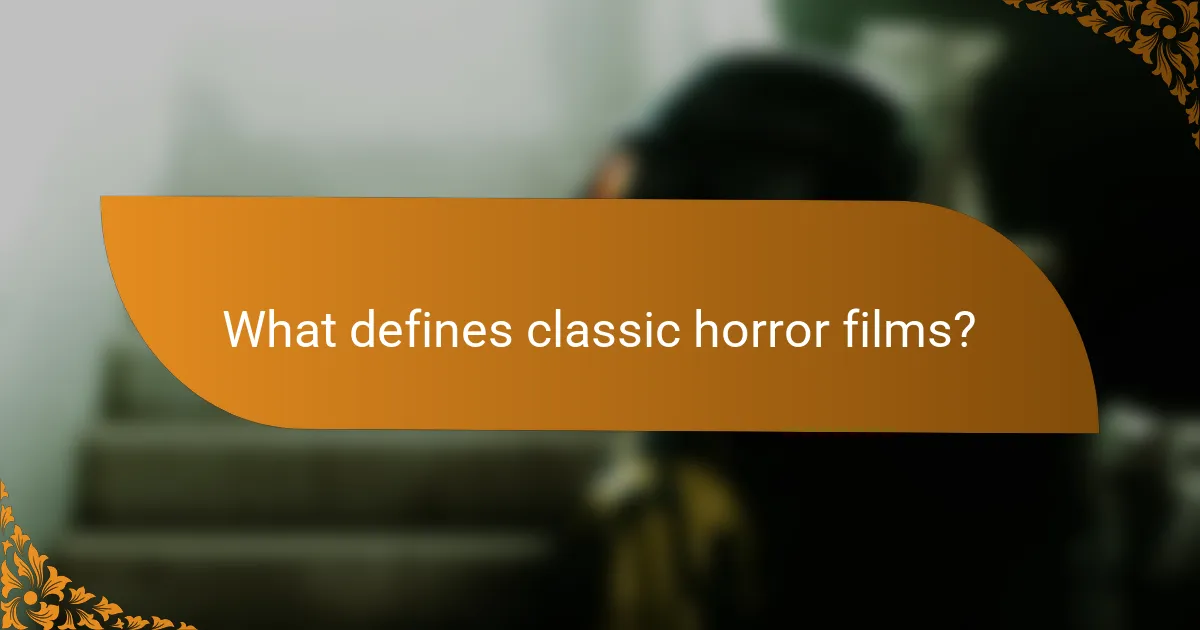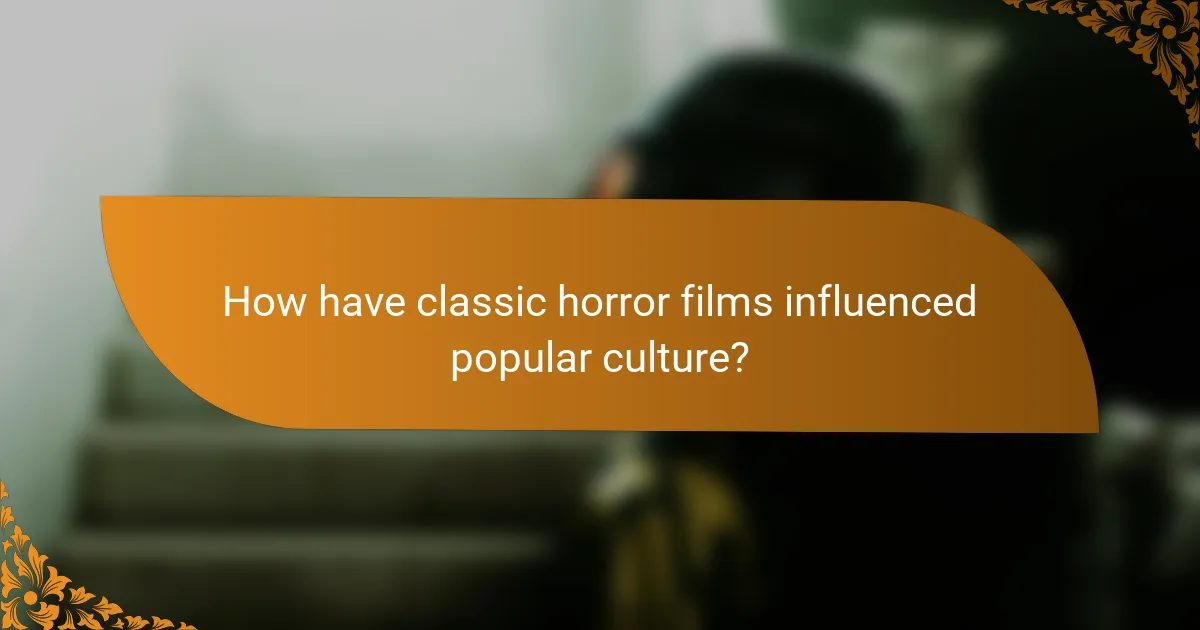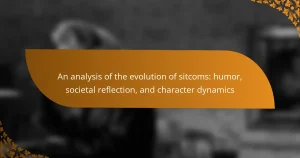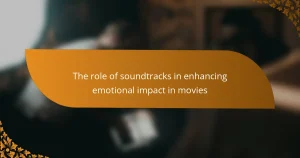
What defines classic horror films?
Classic horror films are defined by their ability to evoke fear and suspense through storytelling, atmosphere, and iconic imagery. These films often feature supernatural elements, such as monsters, ghosts, or psychological terror. They typically explore themes of death, the unknown, and societal fears. Classic horror films are characterized by their use of innovative cinematography and sound design to enhance the eerie experience. Notable examples include “Psycho” (1960) and “Nosferatu” (1922), which have left a lasting impact on the genre. The cultural significance of these films lies in their reflection of societal anxieties during their respective eras.
How did classic horror films emerge in cinema history?
Classic horror films emerged in cinema history primarily during the early 20th century. The genre gained traction with the release of silent films like “The Cabinet of Dr. Caligari” in 1920. This film introduced expressionist techniques that set a precedent for visual storytelling in horror. The advent of sound in the late 1920s further enhanced the genre’s impact. “Dracula” and “Frankenstein,” released in 1931, solidified the classic horror canon. These films were based on popular literature, appealing to audiences’ fears and curiosities. The Great Depression also influenced horror’s popularity, as it provided escapism. Classic horror films often featured iconic monsters, reflecting societal anxieties of the time. Overall, the emergence of classic horror films was a confluence of technological advancements, literary influences, and cultural contexts.
What are the key characteristics of classic horror films?
Classic horror films are defined by their use of suspense, atmosphere, and iconic monsters. They often feature a sense of dread and psychological tension. The settings frequently include isolated locations, such as haunted houses or eerie landscapes. Character archetypes like the monster, the victim, and the hero are prevalent. The use of black-and-white cinematography enhances the eerie mood. Classic horror films often incorporate supernatural elements, such as ghosts or vampires. They rely on sound effects and music to build tension. Many classic horror films address societal fears and anxieties of their time.
Which filmmakers were pivotal in shaping classic horror cinema?
Alfred Hitchcock, F.W. Murnau, and George A. Romero were pivotal in shaping classic horror cinema. Alfred Hitchcock is known for his psychological thrillers, especially “Psycho,” which introduced modern horror elements. F.W. Murnau directed “Nosferatu,” a foundational silent film that defined vampire horror. George A. Romero created “Night of the Living Dead,” which established the modern zombie genre. These filmmakers influenced techniques, themes, and audience expectations in horror cinema. Their works remain significant in film history and continue to inspire contemporary filmmakers.
What themes are prevalent in classic horror films?
Classic horror films often explore themes of fear, the supernatural, and the unknown. Fear is a central theme, often depicted through characters facing their deepest anxieties. The supernatural frequently manifests as ghosts, monsters, or otherworldly beings, challenging the boundaries of reality. The unknown creates tension, as characters confront situations beyond their understanding. Isolation is another prevalent theme, where characters are cut off from help, heightening their vulnerability. Moral dilemmas often arise, showcasing the consequences of characters’ actions. These themes reflect societal fears and anxieties, making classic horror films culturally significant. For example, films like “Dracula” and “Frankenstein” explore the fear of the other and the consequences of scientific hubris.
How do classic horror films reflect societal fears and anxieties?
Classic horror films reflect societal fears and anxieties by embodying the cultural tensions of their time. For example, films like “Frankenstein” (1931) illustrate fears of unchecked scientific progress. The creature symbolizes societal concerns about the consequences of playing God. Similarly, “Night of the Living Dead” (1968) mirrors anxieties surrounding civil rights and social upheaval. The film’s portrayal of a racially diverse group fighting against a common threat highlights the era’s racial tensions. Additionally, “Psycho” (1960) taps into fears of the unknown and mental illness. Norman Bates represents the hidden dangers lurking beneath the surface of everyday life. These films serve as reflections of contemporary issues, allowing audiences to confront their fears through a fictional lens.
What role do monsters and supernatural elements play in these films?
Monsters and supernatural elements serve as central figures in classic horror films. They embody societal fears and anxieties, often reflecting cultural issues of the time. For example, Frankenstein’s monster symbolizes the fear of unchecked scientific advancement. Vampires often represent themes of seduction and moral decay, as seen in “Dracula.” Supernatural elements create suspense and a sense of the unknown, enhancing the emotional impact of the narrative. They also challenge the boundaries of reality, allowing audiences to explore existential questions. These elements are crucial in establishing the horror genre’s identity and cultural significance.

How have classic horror films influenced popular culture?
Classic horror films have profoundly influenced popular culture across various mediums. They introduced iconic characters like Dracula and Frankenstein, which have become cultural symbols. These films have inspired countless remakes and adaptations in cinema and television. They have also shaped the horror genre’s conventions, including tropes such as the final girl and jump scares. Classic horror has permeated literature, influencing authors like Stephen King and H.P. Lovecraft. Merchandise and fan conventions celebrate these films, showcasing their lasting impact. Additionally, classic horror films have influenced fashion, music, and art, as seen in Halloween costumes and themed events. Their legacy continues to resonate in contemporary media, reinforcing their significance in popular culture.
In what ways have classic horror films shaped modern horror genres?
Classic horror films have significantly influenced modern horror genres through thematic innovation and stylistic techniques. They established foundational tropes like the final girl, which continues to appear in contemporary narratives. Classic films introduced psychological horror elements, shaping modern storytelling that explores fear and anxiety. Iconic monsters from classic horror, such as Dracula and Frankenstein, set a precedent for the creation of new horror icons. The use of suspense and atmosphere in classics like “Psycho” has become a blueprint for modern filmmakers. Furthermore, classic horror films often tackled social issues, a trend that persists in today’s horror narratives. The impact of these films is evident in their enduring legacy and the homage paid to them in modern works.
How do references to classic horror appear in contemporary media?
References to classic horror appear frequently in contemporary media through various forms. Films, television shows, and literature often pay homage to iconic elements from classic horror. For example, movies like “It Follows” and “The Cabin in the Woods” incorporate themes and styles reminiscent of earlier horror classics. Television series such as “American Horror Story” feature characters and storylines that echo classic horror tropes. Additionally, modern remakes of classic horror films, like “Halloween” and “Psycho,” showcase updated interpretations of original narratives. Video games, such as “Resident Evil,” also draw heavily from classic horror aesthetics and storytelling techniques. These references serve to connect new audiences with the historical roots of the genre, highlighting its enduring influence. The prevalence of classic horror references indicates its significant cultural impact in shaping contemporary horror narratives.
What impact have classic horror films had on fashion and art?
Classic horror films have significantly influenced fashion and art. Their iconic imagery and themes have permeated various artistic expressions. For instance, the gothic aesthetics seen in films like “Nosferatu” inspired fashion trends emphasizing dark colors and dramatic silhouettes. The use of horror motifs in designer collections has been evident, with brands like Alexander McQueen showcasing macabre elements.
Art movements such as surrealism drew inspiration from the unsettling visuals in classic horror films. The psychological themes explored in these films have also influenced contemporary artists, leading to thought-provoking works. Furthermore, the portrayal of monsters and the grotesque in cinema has inspired visual artists to explore similar themes in their creations.
The impact of classic horror films on fashion and art is evident in the recurring use of horror elements in various creative fields. This influence continues to resonate in modern culture, showcasing the enduring legacy of these films.
Why are classic horror films still relevant today?
Classic horror films remain relevant today due to their enduring themes and cultural impact. These films explore universal fears, such as death and the unknown. They provide a lens through which societal anxieties can be examined. Classic horror often reflects the cultural context of its time, making it a historical artifact. For instance, films like “Psycho” and “Night of the Living Dead” challenged social norms and expectations. They also laid the groundwork for modern horror storytelling. Their influence can be seen in contemporary films and media. This ongoing relevance underscores their significance in film history and popular culture.
How do classic horror films resonate with current audiences?
Classic horror films resonate with current audiences through their timeless themes and cultural relevance. These films often explore human fears, societal anxieties, and moral dilemmas. For instance, movies like “Psycho” and “Night of the Living Dead” reflect issues such as mental health and social unrest.
Current audiences appreciate the nostalgia and stylistic elements of classic horror. The use of practical effects and atmospheric storytelling creates an immersive experience. Additionally, many classic horror films have influenced modern filmmakers, shaping the genre’s evolution.
Research indicates that audiences find comfort in familiar narratives, which classic horror films provide. According to a study by the University of Southern California, horror films allow viewers to confront fears in a safe environment. This connection to contemporary fears enhances the relevance of classic horror films today.
What lessons can modern filmmakers learn from classic horror films?
Modern filmmakers can learn several key lessons from classic horror films. One lesson is the importance of atmosphere in building tension. Classic films like “Psycho” utilized sound and lighting effectively to create unease. Another lesson is the power of suggestion over explicit content. Films such as “The Haunting” demonstrated that what is unseen can be far more frightening. Additionally, character development is crucial. Classic horror often focused on well-rounded characters, making their fates impactful. The use of archetypes, like the final girl trope in “Halloween,” offers insights into audience expectations. Classic horror also emphasizes the value of pacing. Slow builds can enhance suspense, as seen in “The Shining.” Finally, classic horror films often reflect societal fears, teaching modern filmmakers to weave contemporary issues into their narratives for greater relevance.
![]()
What are the most iconic classic horror films and their significance?
The most iconic classic horror films include “Psycho,” “Nosferatu,” “Frankenstein,” and “Dracula.” “Psycho,” directed by Alfred Hitchcock in 1960, revolutionized the horror genre with its shocking plot twists and innovative editing techniques. “Nosferatu,” released in 1922, is significant for being one of the first feature-length horror films, establishing many conventions of the genre. “Frankenstein,” a 1931 film based on Mary Shelley’s novel, introduced the concept of the misunderstood monster, influencing countless adaptations. “Dracula,” also from 1931, popularized the vampire archetype in cinema and set the stage for future vampire narratives. Each of these films has left a lasting impact on horror storytelling, character development, and cinematic techniques.
Which classic horror films are considered must-sees?
Must-see classic horror films include “Psycho,” “Nosferatu,” “The Exorcist,” and “Halloween.” “Psycho,” directed by Alfred Hitchcock in 1960, is renowned for its shocking plot twists and innovative editing techniques. “Nosferatu,” a silent film from 1922, is a seminal work that established many horror tropes. “The Exorcist,” released in 1973, is famous for its portrayal of demonic possession and groundbreaking special effects. “Halloween,” directed by John Carpenter in 1978, set the standard for slasher films and introduced the iconic character Michael Myers. These films have left a lasting impact on the horror genre and are frequently referenced in popular culture.
What makes films like “Dracula” and “Frankenstein” iconic?
Films like “Dracula” and “Frankenstein” are iconic due to their lasting impact on horror cinema and popular culture. They introduced archetypal characters that have become symbols of fear and fascination. “Dracula,” based on Bram Stoker’s novel, popularized the vampire mythos. It established key tropes such as seduction and immortality. “Frankenstein,” adapted from Mary Shelley’s work, explores themes of creation and humanity. It raises moral questions about scientific experimentation. Both films were groundbreaking in their use of special effects and makeup. They influenced countless adaptations and reinterpretations in various media. Their themes resonate with existential fears and societal anxieties, making them timeless. These films laid the groundwork for future horror narratives and character development.
How do these films contribute to the horror genre’s evolution?
Classic horror films contribute to the horror genre’s evolution by introducing innovative storytelling techniques and iconic imagery. These films often explore psychological themes, enhancing audience engagement. For example, “Psycho” (1960) revolutionized the genre with its unexpected plot twists and character development. Additionally, films like “Night of the Living Dead” (1968) redefined horror by incorporating social commentary on race and society. The use of practical effects in movies such as “The Exorcist” (1973) set new standards for visual horror. Classic horror films also established archetypes, such as the final girl trope, influencing future narratives. Their impact is evident in modern horror, where filmmakers draw inspiration from these foundational works. Overall, classic horror films have shaped genre conventions and audience expectations, marking significant milestones in horror’s development.
What cultural impacts have specific classic horror films had?
Classic horror films have significantly influenced cultural perceptions of fear and morality. Movies like “Psycho” redefined the thriller genre and introduced psychological complexity. “Night of the Living Dead” sparked discussions on social issues like race and survival. “Frankenstein” explored themes of creation and responsibility, influencing literature and ethics. These films have also shaped Halloween traditions and popular culture references. Their iconic imagery and characters have become embedded in collective memory. The horror genre has evolved, reflecting societal fears and anxieties over decades. Classic horror films continue to inspire new works and discussions in contemporary media.
How did “Psycho” change the landscape of horror cinema?
“Psycho” changed the landscape of horror cinema by introducing psychological horror elements. Alfred Hitchcock’s film shifted focus from supernatural to psychological terror. It emphasized character-driven narratives over traditional monster tropes. The infamous shower scene redefined violence in film, using suggestion instead of explicit gore. This scene also created a sense of vulnerability in the audience. “Psycho” broke taboos by depicting themes of mental illness and sexuality. Its marketing strategy, promoting secrecy about the plot, changed how films were marketed. “Psycho” influenced countless filmmakers and set a new standard for suspense in horror cinema.
What influence did “Night of the Living Dead” have on zombie culture?
“Night of the Living Dead” significantly shaped zombie culture. It introduced the modern zombie archetype, portraying them as mindless, flesh-eating creatures. This film established key traits such as the undead rising from the grave and the necessity for survival against overwhelming odds. Its stark social commentary addressed issues like racism and consumerism, influencing subsequent narratives. The film’s low-budget production demonstrated that horror could thrive outside mainstream cinema. It also inspired numerous sequels, remakes, and parodies, cementing its place in pop culture. The movie’s impact is evident in the vast number of zombie-related media that followed, including video games and television series. “Night of the Living Dead” became a cultural touchstone, defining the genre for generations.
What can viewers learn from classic horror films today?
Viewers can learn about societal fears and cultural anxieties from classic horror films today. These films often reflect the historical context of their time, showcasing prevalent issues such as war, disease, and social change. For example, “Night of the Living Dead” highlights fears of civil rights and societal collapse during the 1960s. Additionally, classic horror films explore themes of morality and human nature, prompting viewers to reflect on ethical dilemmas. The use of suspense and psychological tension in films like “Psycho” teaches techniques in storytelling and character development. Overall, classic horror films serve as a mirror to human emotions and societal issues, making them relevant for contemporary audiences.
How can classic horror films be used to analyze cultural history?
Classic horror films can be used to analyze cultural history by reflecting societal fears and anxieties. These films often depict the values and issues prevalent during their time of release. For instance, “Frankenstein” released in 1931, addresses themes of scientific ethics and the fear of the unknown. Similarly, “Night of the Living Dead” from 1968 critiques social unrest and racial tensions of the era.
Analyzing character archetypes in these films reveals cultural attitudes towards gender and morality. The portrayal of monsters often symbolizes marginalized groups or societal taboos. For example, Dracula can represent immigrant fears and xenophobia.
Additionally, the evolution of horror films showcases changes in technology and storytelling. The transition from silent films to sound films marked a shift in how horror was experienced. Box office trends also reflect public interest in horror during times of crisis, such as the Great Depression or the Cold War.
Overall, classic horror films serve as a lens through which to examine historical contexts and cultural shifts. They provide insight into collective human experiences and the societal landscape of their respective eras.
What insights do classic horror films provide into human psychology?
Classic horror films reveal deep insights into human psychology by exploring themes of fear, anxiety, and the unknown. They often reflect societal fears and the human condition, showcasing our primal instincts. For example, films like “Psycho” examine the complexities of the human mind and the impact of trauma. The portrayal of monsters often symbolizes internal struggles, such as guilt or repression. Studies show that horror films can serve as a safe space for viewers to confront their fears. Research by Dr. Margee Kerr indicates that horror movies can stimulate adrenaline and provide a cathartic experience. These films also provoke discussions about morality and the nature of evil, prompting viewers to reflect on their values. Overall, classic horror films serve as a mirror to our psychological landscape, revealing both individual and collective anxieties.
Classic horror films are a significant entity in cinema, characterized by their ability to evoke fear through storytelling, atmosphere, and iconic imagery. This article provides a comprehensive overview of classic horror films, exploring their emergence in cinema history, key characteristics, and the pivotal filmmakers who shaped the genre. It examines prevalent themes, the role of monsters and supernatural elements, and the cultural impact of iconic films like “Psycho,” “Nosferatu,” “Frankenstein,” and “Dracula.” Additionally, the article discusses how these films reflect societal fears, their influence on modern horror genres, and their relevance in contemporary media and culture.


